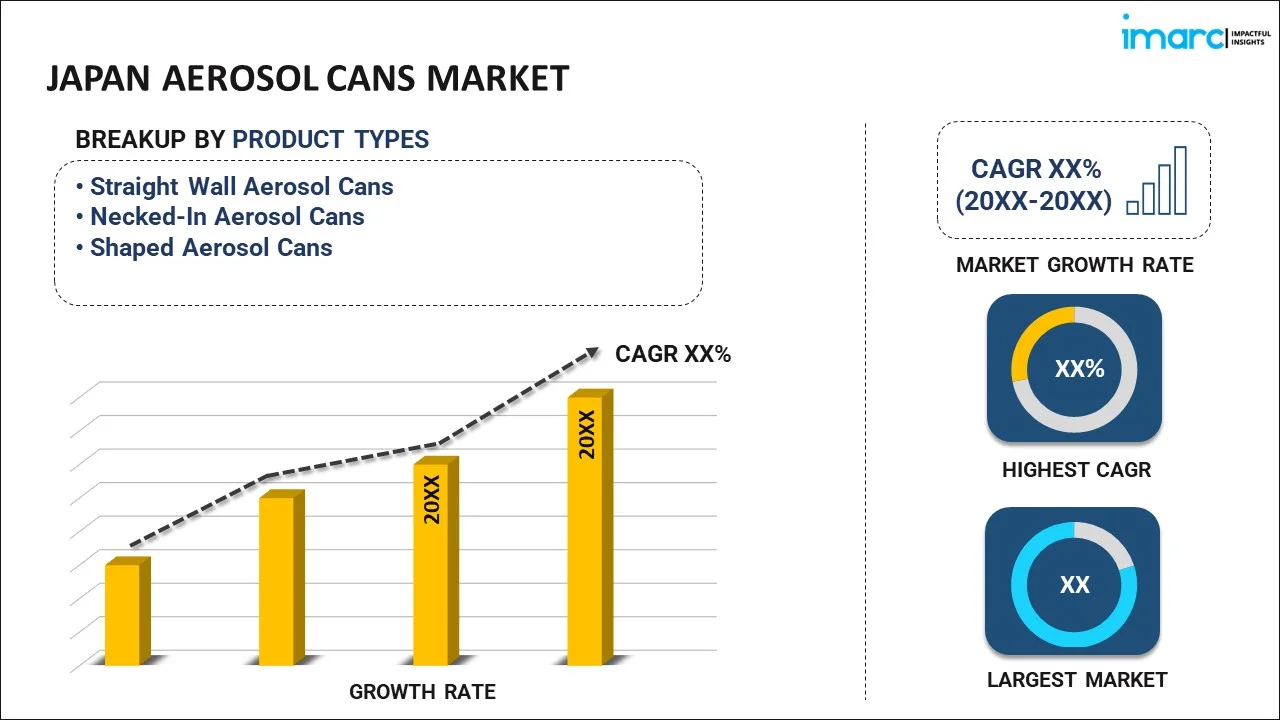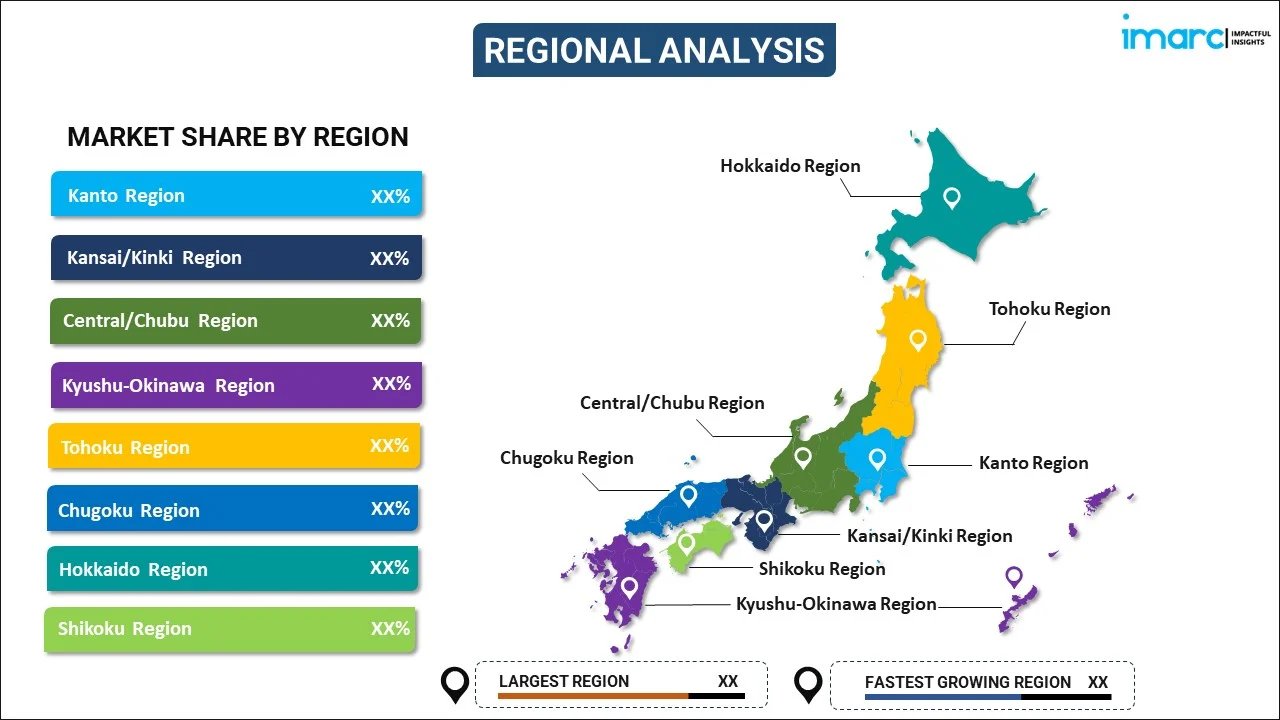
Japan Aerosol Cans Market Report by Product Type (Straight Wall Aerosol Cans, Necked-In Aerosol Cans, Shaped Aerosol Cans), Material (Aluminum, Steel, Plastic, and Others), Propellant Use (Compressed Gas Propellant, Liquefied Gas Propellant), Capacity (<100ml, 100-250 ml, 251-500 ml, >500ml), Application (Personal Care Products, Household Products, Healthcare Products, Automotive Products, and Others), and Region 2025-2033
Market Overview:
Japan aerosol cans market size reached USD 781.0 Million in 2024. Looking forward, IMARC Group expects the market to reach USD 1,060.0 Million by 2033, exhibiting a growth rate (CAGR) of 3.5% during 2025-2033. The increasing demand for convenient packaging solutions, an enhanced focus on sustainability, rapidly expanding cosmetics and personal care industry, the pharmaceutical and healthcare sectors' adoption of aerosol cans, stringent government regulations, and intense market competition represent some of key factors contributing to the market's expansion.
|
Report Attribute
|
Key Statistics
|
|---|---|
|
Base Year
|
2024
|
|
Forecast Years
|
2025-2033
|
|
Historical Years
|
2019-2024
|
| Market Size in 2024 | USD 781.0 Million |
| Market Forecast in 2033 | USD 1,060.0 Million |
| Market Growth Rate 2025-2033 | 3.5% |
Aerosol cans are pressurized containers commonly used to dispense a wide range of products in fine mist or spray form. They are typically composed of three main components: the can itself, a propellant, and the product to be dispensed. The functionality of aerosol cans relies on the principle of propellant expansion. When the valve of the can is depressed, it allows the propellant, often a liquefied gas, such as propane or butane, to expand and push the product out of the can as a fine mist or spray. This mechanism enables the controlled and efficient delivery of various substances, from personal care products like deodorants and hair sprays to household items like insect repellents and cleaning agents. Aerosol cans have a broad spectrum of applications due to their convenience and precision in dispensing products. In the personal care industry, they are extensively used for delivering cosmetics, fragrances, and pharmaceuticals. Additionally, they are employed in the automotive sector for lubricants and anti-rust coatings, in the food industry for cooking sprays, and in the medical field for administering medications. Their versatility extends to the art world, where artists use aerosol cans for spray painting. One of the key advantages of aerosol cans is their ability to maintain product integrity and prevent contamination. The sealed nature of the cans protects the contents from external factors like air and light, preserving their quality and shelf life. Moreover, aerosol cans offer precise and controlled dispensing, reducing waste and ensuring even application. Currently, there are several types of product variants available, including standard aerosol cans, bag-on-valve aerosol cans, and foam aerosol cans, each tailored to specific applications.
Japan Aerosol Cans Market Trends:
The Japan aerosol cans market is influenced by several key drivers, such as the increasing demand for convenient packaging solutions. Consumers in Japan are inclined toward easy-to-use aerosol cans for various products, including personal care and household items. Moreover, escalating environmental consciousness has compelled key players to develop eco-friendly aerosol cans, which is fueling the market growth. Another pivotal driver is the growing cosmetics and personal care industry in Japan. The beauty and grooming sector relies heavily on aerosol packaging for products, such as hairsprays and deodorants. Additionally, the pharmaceutical and healthcare sector is adopting aerosol cans for drug delivery, which is boosting the market growth. In line with this, the food industry is witnessing an increased utilization of aerosol cans for cooking sprays and food preservation, which is positively contributing to the market growth. Furthermore, the government regulations in Japan regarding product safety and packaging standards are driving manufacturers to innovate and meet stringent quality criteria, which is propelling the market growth. Apart from this, the COVID-19 pandemic has increased the use of aerosol disinfectants and sanitizers, thereby contributing to the market growth across the country.
Japan Aerosol Cans Market Segmentation:
IMARC Group provides an analysis of the key trends in each segment of the market, along with forecasts at the country level for 2025-2033. Our report has categorized the market based on product type, material, propellant used, capacity, and application.
Product Type Insights:

- Straight Wall Aerosol Cans
- Necked-In Aerosol Cans
- Shaped Aerosol Cans
The report has provided a detailed breakup and analysis of the market based on the product type. This includes straight wall aerosol cans, necked-in aerosol cans, and shaped aerosol cans.
Material Insights:
- Aluminum
- Steel
- Plastic
- Others
A detailed breakup and analysis of the market based on the material have also been provided in the report. This includes aluminum, steel, plastic, and others.
Propellant Used Insights:
- Compressed Gas Propellant
- Liquefied Gas Propellant
The report has provided a detailed breakup and analysis of the market based on the propellant used. This includes compressed gas propellant and liquefied gas propellant.
Capacity Insights:
- <100ml
- 100-250 ml
- 251-500 ml
- >500ml
A detailed breakup and analysis of the market based on the capacity have also been provided in the report. This includes <100ml, 100-250 ml, 251-500 ml, and >500ml.
Application Insights:
- Personal Care Products
- Household Products
- Healthcare Products
- Automotive Products
- Others
The report has provided a detailed breakup and analysis of the market based on the application. This includes personal care products, household products, healthcare products, automotive products, and others.
Regional Insights:

- Kanto Region
- Kansai/Kinki Region
- Central/ Chubu Region
- Kyushu-Okinawa Region
- Tohoku Region
- Chugoku Region
- Hokkaido Region
- Shikoku Region
The report has also provided a comprehensive analysis of all the major regional markets, which include Kanto Region, Kansai/Kinki Region, Central/ Chubu Region, Kyushu-Okinawa Region, Tohoku Region, Chugoku Region, Hokkaido Region, and Shikoku Region.
Competitive Landscape:
The market research report has also provided a comprehensive analysis of the competitive landscape. Competitive analysis such as market structure, key player positioning, top winning strategies, competitive dashboard, and company evaluation quadrant has been covered in the report. Also, detailed profiles of all major companies have been provided.
Japan Aerosol Cans Market Report Coverage:
| Report Features | Details |
|---|---|
| Base Year of the Analysis | 2024 |
| Historical Period | 2019-2024 |
| Forecast Period | 2025-2033 |
| Units | Million USD |
| Scope of the Report | Exploration of Historical Trends and Market Outlook, Industry Catalysts and Challenges, Segment-Wise Historical and Future Market Assessment:
|
| Product Types Covered | Straight Wall Aerosol Cans, Necked-In Aerosol Cans, Shaped Aerosol Cans |
| Materials Covered | Aluminum, Steel, Plastic, Others |
| Propellant Used Covered | Compressed Gas Propellant, Liquefied Gas Propellant |
| Capacities Covered | <100ml, 100-250 ml, 251-500 ml, >500ml |
| Applications Covered | Personal Care Products, Household Products, Healthcare Products, Automotive Products, Others |
| Regions Covered | Kanto Region, Kansai/Kinki Region, Central/ Chubu Region, Kyushu-Okinawa Region, Tohoku Region, Chugoku Region, Hokkaido Region, Shikoku Region |
| Customization Scope | 10% Free Customization |
| Post-Sale Analyst Support | 10-12 Weeks |
| Delivery Format | PDF and Excel through Email (We can also provide the editable version of the report in PPT/Word format on special request) |
Key Questions Answered in This Report:
- How has the Japan aerosol cans market performed so far and how will it perform in the coming years?
- What has been the impact of COVID-19 on the Japan aerosol cans market?
- What is the breakup of the Japan aerosol cans market on the basis of product type?
- What is the breakup of the Japan aerosol cans market on the basis of material?
- What is the breakup of the Japan aerosol cans market on the basis of propellant used?
- What is the breakup of the Japan aerosol cans market on the basis of capacity?
- What is the breakup of the Japan aerosol cans market on the basis of application?
- What are the various stages in the value chain of the Japan aerosol cans market?
- What are the key driving factors and challenges in the Japan aerosol cans?
- What is the structure of the Japan aerosol cans market and who are the key players?
- What is the degree of competition in the Japan aerosol cans market?
Key Benefits for Stakeholders:
- IMARC’s industry report offers a comprehensive quantitative analysis of various market segments, historical and current market trends, market forecasts, and dynamics of the Japan aerosol cans market from 2019-2033.
- The research report provides the latest information on the market drivers, challenges, and opportunities in the Japan aerosol cans market.
- Porter's five forces analysis assist stakeholders in assessing the impact of new entrants, competitive rivalry, supplier power, buyer power, and the threat of substitution. It helps stakeholders to analyze the level of competition within the Japan aerosol cans industry and its attractiveness.
- Competitive landscape allows stakeholders to understand their competitive environment and provides an insight into the current positions of key players in the market.
Need more help?
- Speak to our experienced analysts for insights on the current market scenarios.
- Include additional segments and countries to customize the report as per your requirement.
- Gain an unparalleled competitive advantage in your domain by understanding how to utilize the report and positively impacting your operations and revenue.
- For further assistance, please connect with our analysts.
 Inquire Before Buying
Inquire Before Buying
 Speak to an Analyst
Speak to an Analyst
 Request Brochure
Request Brochure
 Request Customization
Request Customization




.webp)




.webp)












